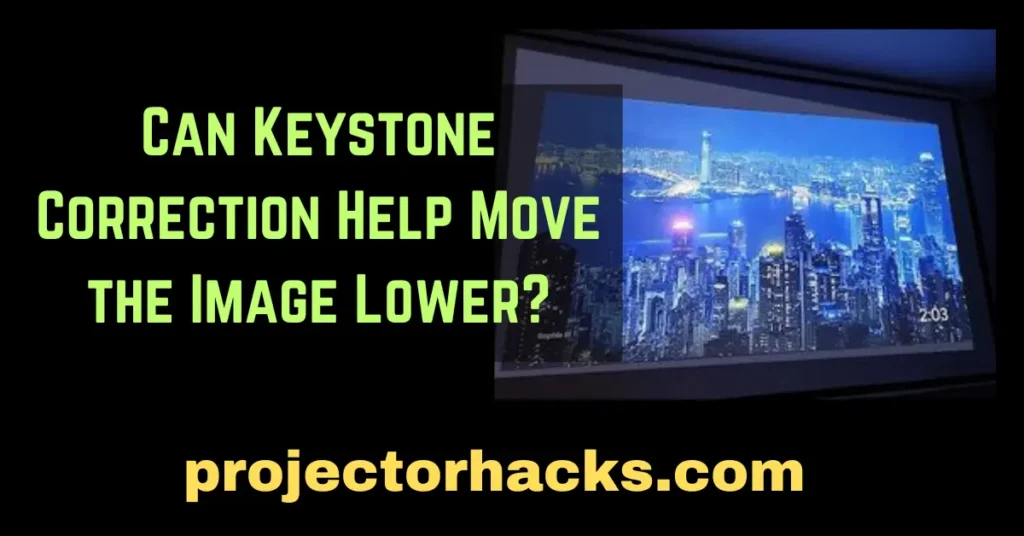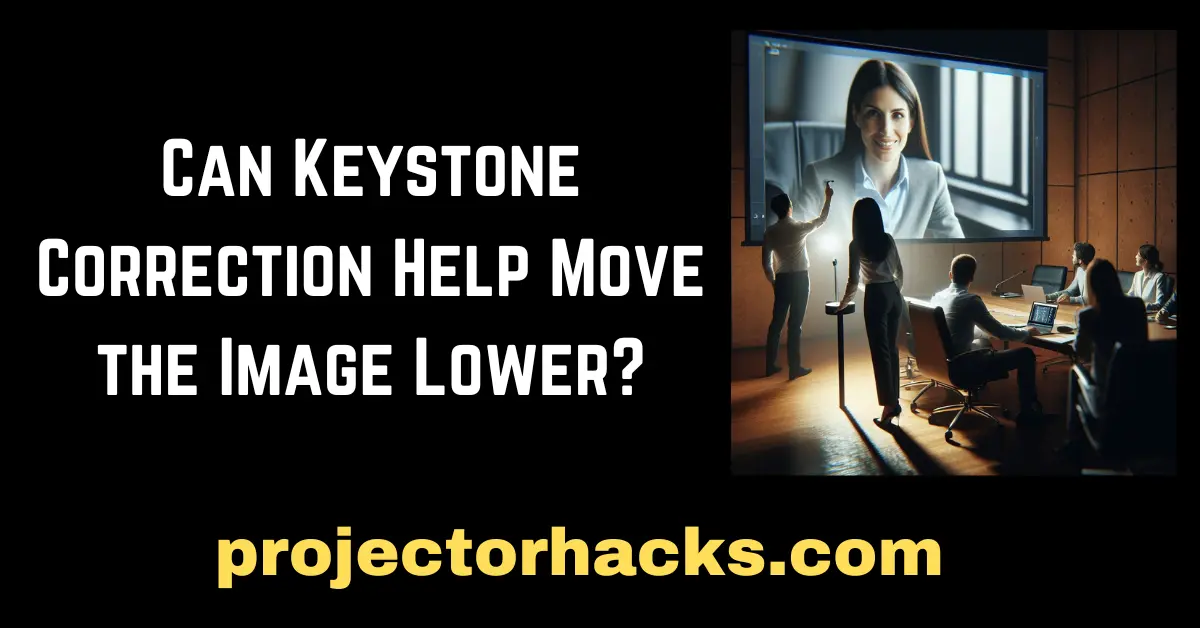In today’s world, technology is getting upgraded day by day with the latest advancements in the market. The industry of projectors is no exception! This field of technology has also progressed and has given birth to some of the major visual correction techniques.
Just imagine you are sitting in the comfort of your home and watching a television show, if the content suddenly starts coming skewed or tilted, how disturbing can it be! Not only this, just imagine you are about to present an important business presentation, and this same issue happens in the board room.
How embarrassing the situation can be! To handle all these scenarios, technical solutions like keystone correction come into help. This is one of the most efficient techniques for attaining visual precision.
In this article, we will explore more about the projector’s technicality and techniques like keystone correction, and its amazing benefits. You will also get to know can keystone correction help move the image lower. Let’s get started with the details.

What is the Major Issue Faced in Projector Systems?
You must know that a projector is not a single solution. Instead, it consists of two parts: the projector and the screen (where the image or video is projected). Sometimes, people don’t use screens, instead, they simply use the walls for the projection. In both scenarios, the same problem arises.
For proper visual precision. The image projection must be perfect. The projector uses an imaging chip which is rectangular, and the image or video which is sent from the projector to the screen should be completely perpendicular to the screen. To get the best visuals, the distance between all the corners and the screen should be equal.
What is the Meaning of Keystone Correction?
Digital keystone correction is one of the best technical features available for projectors to handle this category of issues like distorted images. Sometimes when the projector and the screen are not at the same height, this type of distortion occurs. Next, misalignment can also occur when the projector is not perpendicular to the display screen. For these situations, keystone correction has been introduced.
How does keystone correction work to Fix the Problem of Image Distortion In Projectors?
Keystone Correction plays an important role in solving this issue by digitally altering the projected image to compensate for the distortion caused by the projector’s angle relative to the screen. It essentially fixes the trapezoidal shape that occurs when the projected image is skewed due to improper alignment.
Without keystone correction, viewers would see noticeable misalignment in the projected image, making it difficult to enjoy movies, presentations, or other content. This distortion can be especially bothersome in professional settings, like boardrooms or classrooms, where visual accuracy is key for effective communication.
By using keystone adjustment, users can ensure that the projected image keeps its proper proportions, no matter the projector’s placement or direction. This feature provides flexibility in projector setup, allowing users to project images onto screens or walls from various angles without sacrificing picture quality.
Keystone Correction in Different Technical Settings
Let us explain how keystone correction works in various technical settings:
Home Theater Systems
- In-home theater setups, the projected image is often adjusted to fit perfectly on a screen or wall using keystone correction.
- Users can access keystone correction settings through the projector’s menu or remote control.
- Some advanced projectors automatically detect and correct image distortion without manual steps.
Professional AV Installations
- In places like meeting rooms, auditoriums, or theaters, exact image alignment is important for good viewing experiences.
- Projectors made for professionals usually have advanced keystone correction options, including manual keystone correction adjustment for finely tuning the image shape.
- Integrated calibration tools and geometric correction software may be used to achieve precise alignment in large audiovisual installations.
Projection-Mapping and Immersive Environments
- Showing images onto unusual surfaces, construction parts like walls, or 3D objects to make immersive visual experiences is called projection mapping.
- Correctly adjusting for keystone distortion is important in projection mapping setups to keep accurate image geometry and alignment across complex surfaces.
- Projection mapping software enables users to independently apply keystone correction changes to each mapped region, ensuring a seamless merge with the physical environment.
Digital Signage and Retail Displays
- Digital signage applications regularly need projectors to show content on unusual surfaces like curved walls or oddly shaped displays.
- Keystone correction permits precise modification of the projected image to match the contours of the display surface, confirming optimal visibility and readability.
- Some digital signage solutions incorporate automatically correcting for keystone distortion features to streamline installation and maintenance.
What is the Installation and Calibration Procedure For Keystone Correction?
You need to follow a step-by-step guide for the installation and calibration process of keystone correction projector. Firstly, you need to open the projector menu, find the keystone correction settings, and then follow the on-screen instructions.
- Adjustment of Vertical keystone
- You need to use the remote control to access the vertical keystone correction settings until the perfect square image is obtained.
- In some devices, you get the manual settings on the devices to fix the distortion issues and get the perfectly aligned image on the screen.
- Adjusting Horizontal Keystone
- Just like vertical keystone correction, you can obtain horizontal keystone correction with remote control access.
- In some projectors, you can find on-screen calibration options, and hence, you can directly make the adjustments on the screen for the projected image.
What are the Major Advantages and Disadvantages of Keystone Correction?
One of the major benefits of keystone correction is that it helps to enhance the display of projected images in limited spaces available. With this, you can achieve a perfect rectangular projection on the screen, save all the time wanted for adjusting and positioning your projector relative to the screen, and lastly, it enables you to enjoy various projection angles without any distortion or degradation in the image quality.
However, keystone correction has several disadvantages too that you must learn about before making any decision. There are certain distortions that can’t be helped like distorted edges of projected images, noise in projection, decreased brightness and pixel quality, etc. Moreover, if you are wondering does keystone correction reduce resolution, then yes, it does! All these cons also affect the overall aspect ratio and the color accuracy of the projection.
How to Obtain an Optimized Keystone Correction?
Keep the tips mentioned below to obtain optimized keystone correction:
- You need to maintain the calibration regularly. Whenever you find some inconsistencies, you need to opt for recalibration and obtain a better image quality.
- There are many third-party keystone correction software available that help to smoothen and improve the keystone correction process. Start integrating them for the setup and alignment.
What are the Best Projectors With Keystone Correction?
BenQ TK700 4K HDR Projector: It offers 2D keystone correction to adjust the image shape without any distortion. It is ideal for gaming with a quick 16 millisecond response time at 4K resolution. The bright 3200 lumens ensure clear visuals even in well-lit rooms.
Optoma HD146X High Performance Projector: It features keystone correction to easily align the image on the screen. The bright 3600 lumens create vibrant colors and sharp details in movies and games. An enhanced gaming mode with a rapid 16 millisecond response time allows for smooth gameplay.
ViewSonic PRO8800WUL 5200 Lumens WUXGA HDMI Lens Shift Projector: It offers both keystone correction and lens shift for precise image placement. The high brightness of 5200 lumens and WUXGA resolution create sharp, clear visuals. It is suitable for home theater and office use with versatile connectivity options.
Optoma CinemaX P2 Smart 4K UHD Laser Projector: It provides keystone correction for adjusting the image geometry without any distortion. Laser technology delivers superior image quality.
Final Words
By now, you know everything about the Keystone correction technique. This helps to obtain better image projection in every single setup. Now, you no longer need to worry about titled or distorted projected images. When a projector is not straight in front of the screen, the image looks like a trapezoid. Keystone correction changes the picture digitally so it looks normal again.
You can use keystone correction( horizontal or vertical) to attain the best results. In this way, your visual experience will be enhanced. However, it may result in some image degradation, such as reduced brightness and pixel quality. It also cannot completely eliminate all distortions, particularly at extreme angles.
FAQs
What is keystone correction?
Keystone correction fixes the shape of projected pictures. It is one of the technologies that come along with the projectors to give an enhanced visual experience.
Why is keystone correction important?
It’s important because it makes sure pictures on the wall look right without edges that don’t match up. This helps movies and lessons be easier to see, especially in homes, classrooms, and meeting rooms that use projectors.
Can keystone correction be adjusted manually?
You can often adjust keystone correction yourself using the projector’s remote or on-screen menu. There you can fine-tune the top/bottom and left/right settings to get the picture lining up correctly on the wall.
How do you move the image down on an Epson projector?
You can lower the picture on an Epson projector by adjusting the vertical lens shift or keystone fix settings.
What is the difference between keystone correction and lens shift?
Keystone fix digitally alters the shape of the projected image to correct the distortion caused by the angle of the projector, while lens shift physically moves the lens to adjust the position of the image without distorting it.
How do I adjust the tilt on my projector?
You can adjust the tilt on your projector by using the adjustable feet or mounting brackets to level the projector with the screen or by using keystone correction settings to correct any remaining distortion.
